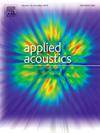Modular low-frequency broadband acoustic absorption structure based on deep ring slits
IF 3.4
2区 物理与天体物理
Q1 ACOUSTICS
引用次数: 0
Abstract
For resonant cavity-type low-frequency broadband acoustic absorbing metamaterials, the broadband acoustic absorption performance relies on the coupling of multiple acoustic absorption peaks. The restriction of small pore size results in a decrease in the bandwidth of individual absorption peaks as the number of coupling units increases and the surface area of the structure expands. Notably, this phenomenon manifests more prominently at lower frequencies. Meanwhile, the realization of broadband sound absorption relies on the precise tuning of small hole parameters. In this study, we propose a modular structure of depth annular slits based on the micro-slit structure. The structure is designed with a series of depth annular micro slits with different inner diameters, which greatly improves the capture efficiency of low-frequency sound waves. Achieving a superior low-frequency broadband acoustic absorption effect with a limited number of units. The finite element model and theoretical model of the structure were constructed, and the sound absorption coefficient was calculated. Furthermore, the intrinsic sound absorption mechanism of the structure is elucidated from the perspectives of absolute sound pressure and sound velocity distribution, relative acoustic impedance, and complex frequency plane. Additionally, the impact of parameter variations on sound absorption curves was investigated. To verify the accuracy of the finite element calculations, experimental samples were fabricated for impedance tube experiments. The results demonstrate that the designed structure effectively realizes low-frequency broadband sound absorption with an average absorption coefficient of 0.89 in the range of 350–710 Hz with five units.
基于深环形狭缝的模块化低频宽带吸声结构
对于谐振腔型低频宽带吸声超材料,其宽带吸声性能依赖于多个吸声峰的耦合。随着耦合单元数量的增加和结构表面积的扩大,小孔径的限制导致单个吸收峰的带宽减小。值得注意的是,这种现象在较低的频率下表现得更为明显。同时,宽带吸声的实现依赖于小孔参数的精确调谐。在本研究中,我们提出了一种基于微缝结构的深度环缝模块化结构。该结构设计了一系列不同内径的深度环形微缝,大大提高了低频声波的捕获效率。以有限的单元数量实现卓越的低频宽带吸声效果。建立了结构的有限元模型和理论模型,计算了结构的吸声系数。从绝对声压声速分布、相对声阻抗、复频率面等角度阐述了结构的内在吸声机理。此外,还研究了参数变化对吸声曲线的影响。为了验证有限元计算的准确性,制作了阻抗管实验样品。结果表明,所设计的结构有效地实现了350 ~ 710 Hz范围内5个单元的低频宽带吸声,平均吸声系数为0.89。
本文章由计算机程序翻译,如有差异,请以英文原文为准。
求助全文
约1分钟内获得全文
求助全文
来源期刊

Applied Acoustics
物理-声学
CiteScore
7.40
自引率
11.80%
发文量
618
审稿时长
7.5 months
期刊介绍:
Since its launch in 1968, Applied Acoustics has been publishing high quality research papers providing state-of-the-art coverage of research findings for engineers and scientists involved in applications of acoustics in the widest sense.
Applied Acoustics looks not only at recent developments in the understanding of acoustics but also at ways of exploiting that understanding. The Journal aims to encourage the exchange of practical experience through publication and in so doing creates a fund of technological information that can be used for solving related problems. The presentation of information in graphical or tabular form is especially encouraged. If a report of a mathematical development is a necessary part of a paper it is important to ensure that it is there only as an integral part of a practical solution to a problem and is supported by data. Applied Acoustics encourages the exchange of practical experience in the following ways: • Complete Papers • Short Technical Notes • Review Articles; and thereby provides a wealth of technological information that can be used to solve related problems.
Manuscripts that address all fields of applications of acoustics ranging from medicine and NDT to the environment and buildings are welcome.
 求助内容:
求助内容: 应助结果提醒方式:
应助结果提醒方式:


